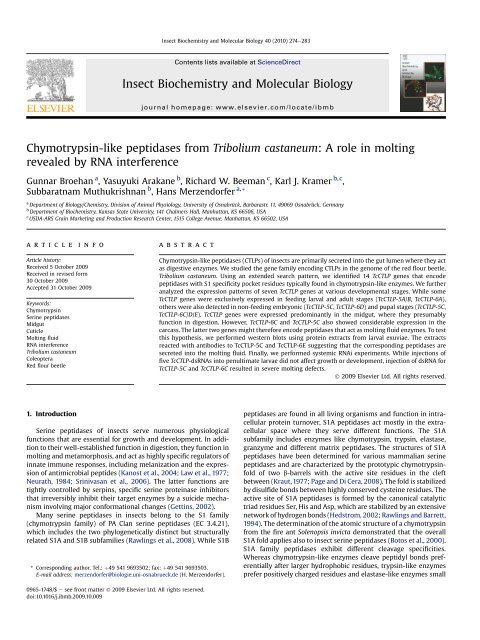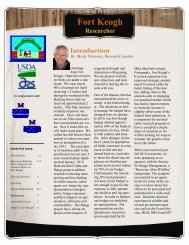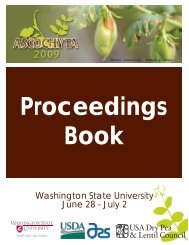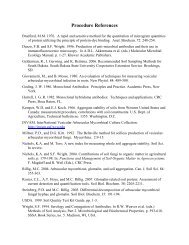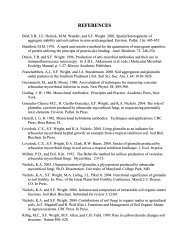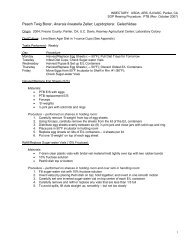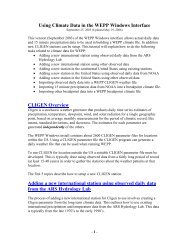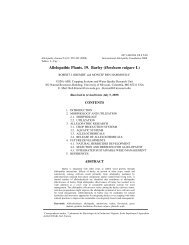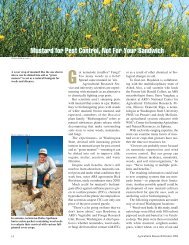Chymotrypsin-like peptidases from Tribolium castaneum: A role in ...
Chymotrypsin-like peptidases from Tribolium castaneum: A role in ...
Chymotrypsin-like peptidases from Tribolium castaneum: A role in ...
You also want an ePaper? Increase the reach of your titles
YUMPU automatically turns print PDFs into web optimized ePapers that Google loves.
<strong>Chymotryps<strong>in</strong></strong>-<strong>like</strong> <strong>peptidases</strong> <strong>from</strong> <strong>Tribolium</strong> <strong>castaneum</strong>: A <strong>role</strong> <strong>in</strong> molt<strong>in</strong>g<br />
revealed by RNA <strong>in</strong>terference<br />
Gunnar Broehan a , Yasuyuki Arakane b , Richard W. Beeman c , Karl J. Kramer b,c ,<br />
Subbaratnam Muthukrishnan b , Hans Merzendorfer a, *<br />
a Department of Biology/Chemistry, Division of Animal Physiology, University of Osnabrück, Barbarastr. 11, 49069 Osnabrück, Germany<br />
b Department of Biochemistry, Kansas State University, 141 Chalmers Hall, Manhattan, KS 66506, USA<br />
c USDA-ARS Gra<strong>in</strong> Market<strong>in</strong>g and Production Research Center, 1515 College Avenue, Manhattan, KS 66502, USA<br />
article <strong>in</strong>fo<br />
Article history:<br />
Received 5 October 2009<br />
Received <strong>in</strong> revised form<br />
30 October 2009<br />
Accepted 31 October 2009<br />
Keywords:<br />
<strong>Chymotryps<strong>in</strong></strong><br />
Ser<strong>in</strong>e <strong>peptidases</strong><br />
Midgut<br />
Cuticle<br />
Molt<strong>in</strong>g fluid<br />
RNA <strong>in</strong>terference<br />
<strong>Tribolium</strong> <strong>castaneum</strong><br />
Coleoptera<br />
Red flour beetle<br />
1. Introduction<br />
abstract<br />
Ser<strong>in</strong>e <strong>peptidases</strong> of <strong>in</strong>sects serve numerous physiological<br />
functions that are essential for growth and development. In addition<br />
to their well-established function <strong>in</strong> digestion, they function <strong>in</strong><br />
molt<strong>in</strong>g and metamorphosis, and act as highly specific regulators of<br />
<strong>in</strong>nate immune responses, <strong>in</strong>clud<strong>in</strong>g melanization and the expression<br />
of antimicrobial peptides (Kanost et al., 2004; Law et al., 1977;<br />
Neurath, 1984; Sr<strong>in</strong>ivasan et al., 2006). The latter functions are<br />
tightly controlled by serp<strong>in</strong>s, specific ser<strong>in</strong>e prote<strong>in</strong>ase <strong>in</strong>hibitors<br />
that irreversibly <strong>in</strong>hibit their target enzymes by a suicide mechanism<br />
<strong>in</strong>volv<strong>in</strong>g major conformational changes (Gett<strong>in</strong>s, 2002).<br />
Many ser<strong>in</strong>e <strong>peptidases</strong> <strong>in</strong> <strong>in</strong>sects belong to the S1 family<br />
(chymotryps<strong>in</strong> family) of PA Clan ser<strong>in</strong>e <strong>peptidases</strong> (EC 3.4.21),<br />
which <strong>in</strong>cludes the two phylogenetically dist<strong>in</strong>ct but structurally<br />
related S1A and S1B subfamilies (Rawl<strong>in</strong>gs et al., 2008). While S1B<br />
* Correspond<strong>in</strong>g author. Tel.: þ49 541 9693502; fax: þ49 541 9693503.<br />
E-mail address: merzendorfer@biologie.uni-osnabrueck.de (H. Merzendorfer).<br />
0965-1748/$ e see front matter Ó 2009 Elsevier Ltd. All rights reserved.<br />
doi:10.1016/j.ibmb.2009.10.009<br />
Insect Biochemistry and Molecular Biology 40 (2010) 274e283<br />
Contents lists available at ScienceDirect<br />
Insect Biochemistry and Molecular Biology<br />
journal homepage: www.elsevier.com/locate/ibmb<br />
<strong>Chymotryps<strong>in</strong></strong>-<strong>like</strong> <strong>peptidases</strong> (CTLPs) of <strong>in</strong>sects are primarily secreted <strong>in</strong>to the gut lumen where they act<br />
as digestive enzymes. We studied the gene family encod<strong>in</strong>g CTLPs <strong>in</strong> the genome of the red flour beetle,<br />
<strong>Tribolium</strong> <strong>castaneum</strong>. Us<strong>in</strong>g an extended search pattern, we identified 14 TcCTLP genes that encode<br />
<strong>peptidases</strong> with S1 specificity pocket residues typically found <strong>in</strong> chymotryps<strong>in</strong>-<strong>like</strong> enzymes. We further<br />
analyzed the expression patterns of seven TcCTLP genes at various developmental stages. While some<br />
TcCTLP genes were exclusively expressed <strong>in</strong> feed<strong>in</strong>g larval and adult stages (TcCTLP-5A/B, TcCTLP-6A),<br />
others were also detected <strong>in</strong> non-feed<strong>in</strong>g embryonic (TcCTLP-5C, TcCTLP-6D) and pupal stages (TcCTLP-5C,<br />
TcCTLP-6C/D/E). TcCTLP genes were expressed predom<strong>in</strong>antly <strong>in</strong> the midgut, where they presumably<br />
function <strong>in</strong> digestion. However, TcCTLP-6C and TcCTLP-5C also showed considerable expression <strong>in</strong> the<br />
carcass. The latter two genes might therefore encode <strong>peptidases</strong> that act as molt<strong>in</strong>g fluid enzymes. To test<br />
this hypothesis, we performed western blots us<strong>in</strong>g prote<strong>in</strong> extracts <strong>from</strong> larval exuviae. The extracts<br />
reacted with antibodies to TcCTLP-5C and TcCTLP-6E suggest<strong>in</strong>g that the correspond<strong>in</strong>g <strong>peptidases</strong> are<br />
secreted <strong>in</strong>to the molt<strong>in</strong>g fluid. F<strong>in</strong>ally, we performed systemic RNAi experiments. While <strong>in</strong>jections of<br />
five TcCTLP-dsRNAs <strong>in</strong>to penultimate larvae did not affect growth or development, <strong>in</strong>jection of dsRNA for<br />
TcCTLP-5C and TcCTLP-6C resulted <strong>in</strong> severe molt<strong>in</strong>g defects.<br />
Ó 2009 Elsevier Ltd. All rights reserved.<br />
<strong>peptidases</strong> are found <strong>in</strong> all liv<strong>in</strong>g organisms and function <strong>in</strong> <strong>in</strong>tracellular<br />
prote<strong>in</strong> turnover, S1A <strong>peptidases</strong> act mostly <strong>in</strong> the extracellular<br />
space where they serve different functions. The S1A<br />
subfamily <strong>in</strong>cludes enzymes <strong>like</strong> chymotryps<strong>in</strong>, tryps<strong>in</strong>, elastase,<br />
granzyme and different matrix <strong>peptidases</strong>. The structures of S1A<br />
<strong>peptidases</strong> have been determ<strong>in</strong>ed for various mammalian ser<strong>in</strong>e<br />
<strong>peptidases</strong> and are characterized by the prototypic chymotryps<strong>in</strong>fold<br />
of two b-barrels with the active site residues <strong>in</strong> the cleft<br />
between (Kraut, 1977; Page and Di Cera, 2008). The fold is stabilized<br />
by disulfide bonds between highly conserved cyste<strong>in</strong>e residues. The<br />
active site of S1A <strong>peptidases</strong> is formed by the canonical catalytic<br />
triad residues Ser, His and Asp, which are stabilized by an extensive<br />
network of hydrogen bonds (Hedstrom, 2002; Rawl<strong>in</strong>gs and Barrett,<br />
1994). The determ<strong>in</strong>ation of the atomic structure of a chymotryps<strong>in</strong><br />
<strong>from</strong> the fire ant Solenopsis <strong>in</strong>victa demonstrated that the overall<br />
S1A fold applies also to <strong>in</strong>sect ser<strong>in</strong>e <strong>peptidases</strong> (Botos et al., 2000).<br />
S1A family <strong>peptidases</strong> exhibit different cleavage specificities.<br />
Whereas chymotryps<strong>in</strong>-<strong>like</strong> enzymes cleave peptidyl bonds preferentially<br />
after larger hydrophobic residues, tryps<strong>in</strong>-<strong>like</strong> enzymes<br />
prefer positively charged residues and elastase-<strong>like</strong> enzymes small
hydrophobic residues at the P1 position. Which type of specificity<br />
actually is exhibited by S1A <strong>peptidases</strong> depends on the properties of<br />
the S1 substrate-b<strong>in</strong>d<strong>in</strong>g pocket, which lies adjacent to the catalytic<br />
site (Perona and Craik,1995). Several conserved am<strong>in</strong>o acid residues<br />
<strong>in</strong> the S1 pocket have been recognized as important determ<strong>in</strong>ants of<br />
substrate specificity, but these may be not the sole decisive factors<br />
for specify<strong>in</strong>g the cleavage site (Hedstrom, 2002). Most S1A <strong>peptidases</strong><br />
are secreted <strong>in</strong>to the extracellular space as <strong>in</strong>active, zymogenic<br />
precursor prote<strong>in</strong>s, which become activated by proteolytic<br />
cleavage at conserved sites (Bode et al., 1978; Neurath and Dixon,<br />
1957; Page and Di Cera, 2008). Zymogen activation reflects<br />
a powerful regulatory mechanism that is frequently embedded <strong>in</strong><br />
a cascade of successive proteolytic steps that together <strong>in</strong>itiate<br />
physiological processes <strong>in</strong> due time at the right place.<br />
Although S1 <strong>peptidases</strong> are one of the best characterized enzyme<br />
families, their precise functions <strong>in</strong> <strong>in</strong>sects are still poorly understood.<br />
Recent genome annotations have allowed the first comprehensive<br />
studies of this peptidase family. The Drosophila genome<br />
conta<strong>in</strong>s more than 200 genes encod<strong>in</strong>g ser<strong>in</strong>e <strong>peptidases</strong> and<br />
homologous enzymes, of which 37 conta<strong>in</strong> regulatory CLIP doma<strong>in</strong>s<br />
at the N-term<strong>in</strong>us (Ross et al., 2003). The vast majority of these genes<br />
encode S1 <strong>peptidases</strong> with a predicted tryps<strong>in</strong>-<strong>like</strong> specificity<br />
(tryps<strong>in</strong>-<strong>like</strong> <strong>peptidases</strong>, TLP). In contrast, only 29 of these genes<br />
were predicted to encode S1A <strong>peptidases</strong> with a predicted chymotryps<strong>in</strong>-<strong>like</strong><br />
specificity (chymotryps<strong>in</strong>-<strong>like</strong> peptidase, CTLP). Also <strong>in</strong><br />
other available <strong>in</strong>sect genomes the total number of genes encod<strong>in</strong>g<br />
CTLPs is rather low compared to the number of genes that encode<br />
TLPs. In Apis mellifera, 57 genes encod<strong>in</strong>g ser<strong>in</strong>e <strong>peptidases</strong> and<br />
homologous enzymes were reported, of which only six had a predicted<br />
chymotryps<strong>in</strong>-<strong>like</strong> specificity (Zou et al., 2006). Similar<br />
results were obta<strong>in</strong>ed when we screened the Anopheles gambiae<br />
genome for ser<strong>in</strong>e <strong>peptidases</strong>. From more than 300 genes encod<strong>in</strong>g<br />
S1 <strong>peptidases</strong>, less than a tenth encode CTLPs. Genomic Southern<br />
blots performed with hybridization probes specific for chymotryps<strong>in</strong>-<strong>like</strong><br />
<strong>peptidases</strong> (CTLPs) <strong>from</strong> Manduca sexta <strong>in</strong>dicated also<br />
a low number ( 8) of genes encod<strong>in</strong>g CTLPs <strong>in</strong> the Manduca genome<br />
(Broehan et al., 2008). Thus, it appears that genes encod<strong>in</strong>g ser<strong>in</strong>e<br />
<strong>peptidases</strong> with a chymotryps<strong>in</strong>-<strong>like</strong> specificity constitute a small<br />
subset with<strong>in</strong> the large gene family encod<strong>in</strong>g S1 <strong>peptidases</strong>.<br />
Those CTLPs that have been identified so far <strong>in</strong> <strong>in</strong>sects are<br />
secreted <strong>in</strong>to the gut lumen where they act as digestive enzymes <strong>in</strong><br />
concert with various other types of <strong>peptidases</strong> (Law et al., 1977;<br />
Sr<strong>in</strong>ivasan et al., 2006; Terra et al., 1996). However, CTLPs may not<br />
be restricted to the <strong>in</strong>test<strong>in</strong>al tract <strong>in</strong> <strong>in</strong>sects, as chymotryps<strong>in</strong>-<strong>like</strong><br />
activities have been reported also <strong>in</strong> the molt<strong>in</strong>g fluid (Brookhart<br />
and Kramer, 1990). The molt<strong>in</strong>g fluid fills the exuvial space between<br />
the old and the new cuticle and exhibits chit<strong>in</strong>olytic and proteolytic<br />
activities that facilitate degradation of the <strong>in</strong>ner layers of the old<br />
cuticle as part of the molt<strong>in</strong>g process before ecdysis. Several<br />
<strong>peptidases</strong> have been identified <strong>in</strong> <strong>in</strong>sect molt<strong>in</strong>g fluids, <strong>in</strong>clud<strong>in</strong>g<br />
tryps<strong>in</strong>-<strong>like</strong> ser<strong>in</strong>e <strong>peptidases</strong>, carboxy<strong>peptidases</strong>, cyste<strong>in</strong>e <strong>peptidases</strong><br />
and metallo<strong>peptidases</strong> such as am<strong>in</strong>o<strong>peptidases</strong> (Dong et al.,<br />
2007; Liu et al., 2006, 2009; Ote et al., 2005; Rabossi et al., 2008;<br />
Samuels et al., 1993a,b; Sui et al., 2009; Wei et al., 2007).<br />
To ga<strong>in</strong> more <strong>in</strong>sights <strong>in</strong>to the functions of CTLPs, we have<br />
characterized the gene family encod<strong>in</strong>g these <strong>peptidases</strong> <strong>in</strong> the red<br />
flour beetle, <strong>Tribolium</strong> <strong>castaneum</strong>, a well-established genetic and<br />
genomic <strong>in</strong>sect model (Brown et al., 2003; Richards et al., 2008).<br />
We used an extended search pattern to identify S1A <strong>peptidases</strong><br />
with S1 specificity pocket residues that are typically found <strong>in</strong><br />
enzymes that exhibit chymotryps<strong>in</strong>-<strong>like</strong> activity. In do<strong>in</strong>g so, we<br />
identified 14 genes <strong>in</strong> the <strong>Tribolium</strong> genome that encode CTLPs<br />
(TcCTLPs). Analysis of the expression patterns of seven TcCTLP genes<br />
revealed that most enzymes were expressed dur<strong>in</strong>g feed<strong>in</strong>g stages<br />
<strong>in</strong> the midgut, which is consistent with a <strong>role</strong> <strong>in</strong> digestion of food<br />
G. Broehan et al. / Insect Biochemistry and Molecular Biology 40 (2010) 274e283 275<br />
material. However, two of these genes, TcCTLP-5C and TcCTLP-6C,<br />
were found to be expressed also <strong>in</strong> the carcass and were immunodetected<br />
<strong>in</strong> prote<strong>in</strong> extracts <strong>from</strong> larval exuviae. F<strong>in</strong>ally, RNAi<br />
experiments demonstrated that TcCTLP-5C and TcCTLP-6C are<br />
essential enzymes <strong>in</strong> the molt<strong>in</strong>g process.<br />
2. Materials and methods<br />
2.1. Insects<br />
The T. <strong>castaneum</strong> stra<strong>in</strong> GA-1 (Haliscak and Beeman, 1983) was<br />
used <strong>in</strong> this study. Insects were reared at 30 C under standard<br />
conditions (Beeman and Stuart, 1990).<br />
2.2. Clon<strong>in</strong>g of cDNAs encod<strong>in</strong>g TcCTLPs<br />
The cDNAs for the seven TcCTLPs, TcCTLP-5A (embljCBC01177.1),<br />
TcCTLP-5B (embljCBC01166.1), TcCTLP-5C1 (embljCBC01175.1), TcCTLP-<br />
5C2 (embljCBC01172.1), TcCTLP-6A (embljCBC01171.1), TcCTLP-6C<br />
(embljCBC01169.1), TcCTLP-6D (embljCBC01179.1) and TcCTLP-6E<br />
(embljCBC01181.1) identified <strong>in</strong> the <strong>Tribolium</strong> genome were amplified<br />
by RT-PCR us<strong>in</strong>g gene-specific primers (Table S1, supplementary data)<br />
and total RNA <strong>from</strong> the larval midgut. The PCR products were ligated<br />
<strong>in</strong>to the pGEM-T vector (Promega) and amplified <strong>in</strong> a-select competent<br />
cells (Biol<strong>in</strong>e). Plasmid DNA was isolated us<strong>in</strong>g the Plasmid M<strong>in</strong>i<br />
Kit (Qiagen) and the <strong>in</strong>serts were sequenced (Sequenc<strong>in</strong>g Core<br />
Facility, Dept. of Plant Pathology, Kansas State University). Sequences<br />
matched those published <strong>in</strong> Beetlebase (http://beetlebase.org/) and<br />
NCBI's GenBank (http://blast.ncbi.nlm.nih.gov) except for a few<br />
nucleotide substitutions. A near-full-length TcCTLP-5C cDNA could<br />
not be amplified <strong>in</strong> the first attempt. However, we were able to<br />
amplify a central 263 bp cDNA fragment of TcCTLP-5C us<strong>in</strong>g the PCR<br />
primers TcCTLP-5C-F and TcCTLP-5C-R (Table S1, supplementary<br />
data). Completion of the miss<strong>in</strong>g 5 0 -and3 0 -sequences of TcCTLP-5C<br />
was accomplished with the FirstChoice RLM-RACE Kit (Ambion) and<br />
the gene-specific primers TcCTLP-5C-5 0 -Out and TcCTLP-5C-5 0 -In for<br />
5’RACE and TcCTLP-5C-3 0 -Out and TcCTLP-5C-3 0 -In for 3’RACE<br />
(Table S1, supplementary data).<br />
2.3. Gene expression analysis by RT-PCR<br />
Total RNA was isolated <strong>from</strong> pools of embryos, young larvae, last<br />
<strong>in</strong>star larvae, pharate pupae, pupae and adults us<strong>in</strong>g the RNeasy<br />
M<strong>in</strong>i kit (Qiagen) as recommended by the manufacturer. Total RNA<br />
was used as a template for cDNA synthesis with the SuperScript III<br />
First-Strand Synthesis System (Invitrogen). The expression profile<br />
for each gene was determ<strong>in</strong>ed with pairs of gene-specific primers<br />
(Table S1, supplementary data). To monitor tissue specificity of<br />
expression by RT-PCR, total RNA was prepared <strong>from</strong> midgut and<br />
carcass tissues of young and last <strong>in</strong>star larvae and prepupae. The<br />
carcass tissue was obta<strong>in</strong>ed by remov<strong>in</strong>g the head, the two last<br />
abdom<strong>in</strong>al segments and the complete gut. The RNA was reversetranscribed<br />
<strong>in</strong>to cDNA and the latter used as template for RT-PCR<br />
us<strong>in</strong>g pairs of gene-specific primers (Table S1, supplementary data).<br />
RT-PCR performed with primers for ribosomal prote<strong>in</strong> S6 (TcRPS6,<br />
GenBankjXP_968395.1; Table S1, supplementary data; Arakane<br />
et al., 2009) was used as an <strong>in</strong>ternal control for cDNA synthesis and<br />
equal load<strong>in</strong>g of PCR products. Each RT-PCR experiment was<br />
performed us<strong>in</strong>g three different cycle numbers.<br />
2.4. dsRNA synthesis and <strong>in</strong>jection <strong>in</strong>to <strong>Tribolium</strong><br />
For dsRNA synthesis the pGEM-T-TcCTLP vectors were used as<br />
templates <strong>in</strong> a PCR with primers conta<strong>in</strong><strong>in</strong>g T7 promoter sequences at<br />
the 5 0 -end and a sequence specificforthecorrespond<strong>in</strong>gTcCTLP cDNA
276<br />
(Table S1, supplementary data). After agarose gel electrophoresis, PCR<br />
products were excised and purified with the QIAquick Gel Extraction<br />
Kit (Qiagen), subsequently used as templates for dsRNA synthesis<br />
performed with the AmpliScribe T7-Flash transcription kit<br />
(Epicentre). For RNAi experiments at least 30 penultimate <strong>in</strong>star<br />
larvae, prepupae, pupae (two days old) or adults (shortly after eclosion)<br />
were anesthetized by exposure to ether for 3 m<strong>in</strong> or by chill<strong>in</strong>g<br />
on ice <strong>in</strong> case of the adults. Anesthetized <strong>in</strong>sects were <strong>in</strong>jected with<br />
200 nl of the <strong>in</strong>dicated <strong>Tribolium</strong> CTLP dsRNA (1 mg/ml; <strong>in</strong> 0.1 mM<br />
potassium phosphate buffer conta<strong>in</strong><strong>in</strong>g 5 mM KCl, pH 7; Tomoyasu<br />
and Denell, 2004). After <strong>in</strong>jection, the <strong>in</strong>sects were kept under standard<br />
conditions for visual monitor<strong>in</strong>g of phenotypes and further<br />
analysis. Phenotypes were monitored on a daily basis with the help<br />
of a stereomicroscope (Leica). Buffer conta<strong>in</strong><strong>in</strong>g dsRNA for the <strong>Tribolium</strong><br />
tryptophan oxygenase gene (TcVer; GenBankjNP_001034499.1;<br />
Arakane et al., 2009) was <strong>in</strong>jected as a control.<br />
2.5. Monitor<strong>in</strong>g the knockdown of transcript levels<br />
Total RNA was prepared <strong>from</strong> pools of four <strong>in</strong>sects three days<br />
after <strong>in</strong>jection of dsRNA by us<strong>in</strong>g the RNeasy M<strong>in</strong>i Kit (Qiagen). The<br />
preparation was used to synthesize cDNA with SuperScript III First-<br />
Strand Synthesis System (Invitrogen) as described above. RT-PCR<br />
us<strong>in</strong>g gene-specific primers (Table S1, supplementary data) was<br />
carried out with different cycle numbers to compare the effect of<br />
TcCTLP-dsRNA <strong>in</strong>jections with those of TcVer-dsRNA <strong>in</strong>jections at<br />
the level of transcripts. The effects of TcCTLP-dsRNA <strong>in</strong>jection were<br />
additionally analyzed for possible non-target effects by compar<strong>in</strong>g<br />
the transcript levels of closely related TcCTLPs. RT-PCR with TcRPS6<br />
primers (Table S1, supplementary data) served as an <strong>in</strong>ternal<br />
control for cDNA synthesis and equal load<strong>in</strong>g of PCR products.<br />
2.6. Expression of recomb<strong>in</strong>ant TcCTLPs and antibody generation<br />
For the generation of recomb<strong>in</strong>ant TcCTLP-5C2 and TcCTLP-6C<br />
prote<strong>in</strong>s, RT-PCR was performed, us<strong>in</strong>g primers conta<strong>in</strong><strong>in</strong>g a 5 0<br />
BamHI (TcCTLP-5C2-BH-F; TcCTLP-6C-BH-F; Table S1, supplementary<br />
data) and a 3 0 H<strong>in</strong>dIII restriction site (TcCTLP-5C2-BH-R;<br />
TcCTLP-6C-BH-R; Table S1, supplementary data) amplify<strong>in</strong>g the<br />
complete open read<strong>in</strong>g frame <strong>in</strong> addition to a sequence cod<strong>in</strong>g for<br />
an C-term<strong>in</strong>al octa-His-tag. PCR products were separated by gel<br />
electrophoresis, excised and purified with the QIAquick Gel<br />
Extraction Kit (Qiagen). After cleavage with BamHI and H<strong>in</strong>dIII (New<br />
England Biolabs), the products were ligated <strong>in</strong>to the pFast-Bac-Dual<br />
(pFBD) vector, which additionally conta<strong>in</strong>ed a sequence cod<strong>in</strong>g for<br />
an enhanced green fluorescence prote<strong>in</strong> (EGFP) under the control<br />
of a p10 promoter (a k<strong>in</strong>d gift of Dr. Monique van Oers, Wagen<strong>in</strong>gen<br />
University). The vectors were amplified <strong>in</strong> DH5a cells, isolated with<br />
the Plasmid M<strong>in</strong>i Kit (Qiagen) and used for transformation of<br />
DH10Bac cells. After recomb<strong>in</strong>ation, high molecular weight bacmid<br />
DNA was isolated and used for the <strong>in</strong>fection of Sf21 <strong>in</strong>sect cells.<br />
After amplification of recomb<strong>in</strong>ant viruses, the supernatants of the<br />
cell cultures were used to <strong>in</strong>fect Hi-5 cells at 70e80% confluence,<br />
which were <strong>in</strong>cubated at 27 C. After <strong>in</strong>spection of EGFP expression<br />
with a fluorescence microscope (Olympus IX70), cells were harvested<br />
5 days after <strong>in</strong>fection and the culture's supernatant obta<strong>in</strong>ed<br />
by a 600 g centrifugation for 10 m<strong>in</strong> was submitted to a Ni-NTA<br />
agarose column (Qiagen). Elution of bound prote<strong>in</strong>s was accomplished<br />
by a step gradient of imidazole <strong>in</strong> elution buffer <strong>from</strong> 20 to<br />
500 mM (100 mM steps; elution buffer: 50 mM NaH2PO4, 300mM<br />
NaCl, 20 mM imidazole, pH 8.0). Recomb<strong>in</strong>ant TcCTLP-6C eluted at<br />
an imidazole concentration of about 0.2 M. Ni-NTA purification was<br />
not sufficient for TcCTLP-5C. For this reason, the recomb<strong>in</strong>ant<br />
peptidase was purified on a Mono Q anion exchange column (GE<br />
Healthcare) equilibrated with runn<strong>in</strong>g buffer (20 mM TriseHCl,<br />
G. Broehan et al. / Insect Biochemistry and Molecular Biology 40 (2010) 274e283<br />
50 mM NaCl, pH 8.1). Bound prote<strong>in</strong> was eluted with a l<strong>in</strong>ear NaCl<br />
gradient (0.05e1 M NaCl, 20 mM per m<strong>in</strong>) <strong>in</strong> runn<strong>in</strong>g buffer.<br />
Recomb<strong>in</strong>ant TcCTLP-5C eluted at about 0.2 M NaCl. The purified<br />
prote<strong>in</strong>s were lyophilized after SDS-PAGE to check their <strong>in</strong>tegrity<br />
and correct size (Fig. 7, lane 1). Recomb<strong>in</strong>ant TcCTLP-5C was used to<br />
immunize mice (Charles River) and recomb<strong>in</strong>ant TcCTLP-6C was<br />
used to immunize rabbits (P<strong>in</strong>eda, Germany).<br />
2.7. Other methods<br />
For the preparation of midgut tissues, midguts <strong>from</strong> 20 larvaewere<br />
dissected <strong>in</strong> dissection buffer (0.1 M potassium phosphate, pH 7) and<br />
homogenized. Exuviae of 40 larvae were homogenized <strong>in</strong> dissection<br />
buffer and subsequently boiled for five m<strong>in</strong>utes <strong>in</strong> SDS-PAGE sample<br />
buffer (2% SDS (w/v), 5% sucrose (w/v), 0.125 M Tris HCl, pH 6.8,<br />
0.005% bromophenol blue (w/v), 2% 2-mercaptoethanol (v/v)). SDS-<br />
PAGE was performed accord<strong>in</strong>g to Laemmli (1970). Semi-dry electroblott<strong>in</strong>g<br />
of polyacrylamide gels onto nitrocellulose membranes<br />
(Millipore) was carried out with a buffer system accord<strong>in</strong>g to Kyhse-<br />
Andersen (1984),andmodified by the addition of 20% methanol. Blot<br />
membranes were sta<strong>in</strong>ed with 0.02% (v/v) Ponceau S (SigmaeAldrich).<br />
Immunoblots were performed as described previously<br />
(Zimoch and Merzendorfer, 2002). The immunoreactions were<br />
carried out with polyclonal anti-TcCTLP-5C (1:100) and anti-TcCTLP-<br />
6C antibodies (1:10 000). The secondary antibodies were anti-rabbit<br />
or anti-mouse antibodies conjugated with alkal<strong>in</strong>e phosphatase<br />
(1:10 000 and 1:30 000 dilutions, respectively; SigmaeAldrich).<br />
3. Results<br />
3.1. Identification of CTLP-encod<strong>in</strong>g genes <strong>in</strong> the <strong>Tribolium</strong> genome<br />
To identify genes encod<strong>in</strong>g chymotryps<strong>in</strong>-<strong>like</strong> <strong>peptidases</strong>, we<br />
performed a tblastn search of the <strong>Tribolium</strong> genome database at<br />
NCBI us<strong>in</strong>g the M. sexta CTLP1 (MsCTLP1; embljCAL92020.1; Broehan<br />
et al., 2007) as query. From the result<strong>in</strong>g list of homologous<br />
sequences, we selected those that showed a chymotryps<strong>in</strong>-<strong>like</strong><br />
substrate specificity pocket as def<strong>in</strong>ed by Perona and Craik (1995).<br />
Accord<strong>in</strong>gly, prote<strong>in</strong>s conta<strong>in</strong><strong>in</strong>g the residues Ser/Thr190, Gly216,<br />
and Gly/Ala/Ser226 <strong>in</strong> the primary substrate-b<strong>in</strong>d<strong>in</strong>g pocket were<br />
classified as chymotryps<strong>in</strong>-<strong>like</strong> <strong>peptidases</strong>. However, we extended<br />
this def<strong>in</strong>ition by <strong>in</strong>clud<strong>in</strong>g ser<strong>in</strong>e <strong>peptidases</strong> with the residues<br />
Gly190, Gly216, and Asp226, as reported for Spodoptera exigua<br />
SeCT34 and A. gambiae Anchym1, two ser<strong>in</strong>e <strong>peptidases</strong> that<br />
evidently exhibit chymotryps<strong>in</strong>-<strong>like</strong> activity (Herrero et al., 2005;<br />
Vizioli et al., 2001). Moreover, several chymotryps<strong>in</strong>-<strong>like</strong> <strong>peptidases</strong><br />
<strong>from</strong> Manduca (MsCTLP1-4) have been described recently, which<br />
possess these specificity pocket residues as well (Broehan et al.,<br />
2008, 2007). By extend<strong>in</strong>g the search pattern to Gly/Ser/Thr190,<br />
Gly216, and Asp/Gly/Ala/Ser226 and us<strong>in</strong>g the sequences identified<br />
by the <strong>in</strong>itial search as queries <strong>in</strong> <strong>in</strong>dividual PSI-BLAST searches, we<br />
obta<strong>in</strong>ed a total of 14 TcCTLP genes, six more than previously<br />
published when we only used the orig<strong>in</strong>al S1 pocket residues<br />
(Broehan et al., 2008). We denoted the genes accord<strong>in</strong>g to their<br />
l<strong>in</strong>kage group by number and their physical order on the chromosome<br />
by letter. For <strong>in</strong>stance, TcCTLP-6C is the third gene on<br />
chromosome 6 encod<strong>in</strong>g a chymotryps<strong>in</strong>-<strong>like</strong> peptidase. Comparison<br />
of the <strong>Tribolium</strong> and Drosophila genomes revealed no conservation<br />
of synteny of CTLPs. Only small gene clusters of CTLPs can be<br />
observed <strong>in</strong> both species.<br />
3.2. Isolation and sequenc<strong>in</strong>g of TcCTLP cDNAs<br />
To confirm the gene models and derived am<strong>in</strong>o acid sequences,<br />
we cloned and sequenced the cDNAs of seven selected TcCTLPs.
Overall, we could experimentally confirm the predicted or<br />
manually curated mRNA sequences <strong>in</strong> the genome database. Some<br />
differences <strong>in</strong> the nucleotide sequences turned out to be silent<br />
nucleotide substitutions, but a few led to changes <strong>in</strong> the deduced<br />
am<strong>in</strong>o acid sequences. These changes <strong>in</strong>clude conserved and nonconserved<br />
am<strong>in</strong>o acid substitutions: TcCTLP-5A: S-19-R, D-110-E<br />
and L-215-P; TcCTLP-6C: T-8-S, G-14-A and G-51-S; TcCTLP-6D:<br />
G-148-K, I-175-L, S-189-T and S-210-N; TcCTLP-6E: A-22-T, Q-98-K,<br />
N-109-D, S-151-G, G-192-R, V-194-I, S-220-P and I-227-V. The<br />
latter substitutions might be due to the fact that the T. <strong>castaneum</strong><br />
stra<strong>in</strong> used for genomic sequenc<strong>in</strong>g was the highly <strong>in</strong>bred<br />
GA2 stra<strong>in</strong> (Richards et al., 2008) and not the more highly polymorphic<br />
GA1 stra<strong>in</strong> used <strong>in</strong> this work. Furthermore, midgut ser<strong>in</strong>e<br />
<strong>peptidases</strong> may exhibit a high evolutionary rate as an adaptative<br />
mechanism to counteract plant ser<strong>in</strong>e peptidase <strong>in</strong>hibitors<br />
(Sr<strong>in</strong>ivasan et al., 2006).<br />
Because we could <strong>in</strong>itially amplify only a central fragment of the<br />
cDNA for TcCTLP-5C by RT-PCR, we performed 5 0 - and 3 0 -RACE to<br />
complete the sequence. The 5 0 -RACE experiment yielded both long<br />
and short products, which turned out to be identical <strong>in</strong> their<br />
nucleotide sequences with the exception of a 57 bp region that was<br />
present only <strong>in</strong> the longer RACE product (Fig. 1 and S1, supplementary<br />
data). Also the 3 0 -RACE experiment performed with<br />
a forward primer that <strong>in</strong>cluded the 57 bp region of the longer<br />
5 0 -RACE product yielded longer and shorter products for TcCTLP-5C.<br />
The 5 0 - as well as the 3 0 -fragments perfectly overlapped with the<br />
<strong>in</strong>itially obta<strong>in</strong>ed central fragment of TcCTLP-5C. RT-PCR with correspond<strong>in</strong>g<br />
5 0 - and 3 0 -primers to amplify the complete cod<strong>in</strong>g<br />
sequence, and subsequent nucleotide sequenc<strong>in</strong>g f<strong>in</strong>ally confirmed<br />
G. Broehan et al. / Insect Biochemistry and Molecular Biology 40 (2010) 274e283 277<br />
the existence of two TcCTLP-5C variants, a long two exon-spann<strong>in</strong>g<br />
cDNA of 798 bp (TcCTLP-5C1) and a shorter three exon-spann<strong>in</strong>g<br />
cDNA of 741 bp (TcCTLP-5C2). These variants are probably the result<br />
of alternative splic<strong>in</strong>g of the 57 nucleotides spann<strong>in</strong>g <strong>in</strong>tron, which<br />
is excised via conserved 5 0 - and 3 0 -splic<strong>in</strong>g sites only <strong>in</strong> TcCTLP-5C2.<br />
All seven TcCTLPs meet the structural requirements of S1 family<br />
<strong>peptidases</strong> (Fig. 1) as they possess the conserved histid<strong>in</strong>e, aspartate<br />
and ser<strong>in</strong>e residues that form the catalytic triad. Additionally,<br />
they all share the highly conserved GDSGGP motif around the<br />
catalytic ser<strong>in</strong>e (Table 1) as well as the six conserved cyste<strong>in</strong>e<br />
residues typically present <strong>in</strong> <strong>in</strong>vertebrate S1A <strong>peptidases</strong> (Yan et al.,<br />
2001). With the exception of TcCTLP-6B and TcCTLP-6D the <strong>Tribolium</strong><br />
CTLPs are probably expressed as zymogens that are activated<br />
upon tryptic cleavage, as they possess conserved ArgeIle bonds<br />
(Table 1 and Fig. 1; Lehane and Bill<strong>in</strong>gsley, 1996; Peterson et al.,<br />
1995). All TcCTLPs are presumably secretory prote<strong>in</strong>s because the<br />
predicted prote<strong>in</strong>s conta<strong>in</strong> N-term<strong>in</strong>al signal peptides for the<br />
secretory pathway predicted to be cleaved after am<strong>in</strong>o acid position<br />
18 for TcCTLP-5A, position 17 for TcCTLP-5B, position 23 for TcCTLP-<br />
5C, position 16 for TcCTLP-6A and TcCTLP-6D, position 17 for<br />
TcCTLP-6C and position 20 for TcCTLP-6E (Table 1 and Fig. 1; SignalP<br />
v3.0, Emanuelsson et al., 2007). The overall gene structure for the<br />
seven selected TcCTLPs revealed strik<strong>in</strong>g differences. While TcCTLP-<br />
5A, TcCTLP-5B, TcCTLP-6A and TcCTLP-6D conta<strong>in</strong> three exons and<br />
two <strong>in</strong>trons, TcCTLP-6C has only two exons and one <strong>in</strong>tron, and<br />
TcCTLP-6E has six exons and five <strong>in</strong>trons. In contrast, TcCTLP-5C is<br />
alternatively spliced and hence conta<strong>in</strong>s either two or three exons<br />
along with one or two <strong>in</strong>trons, depend<strong>in</strong>g on which transcript is<br />
generated (Fig. S1, supplementary data).<br />
Fig. 1. ClustalW alignment of chymotryps<strong>in</strong>-<strong>like</strong> <strong>peptidases</strong> <strong>from</strong> <strong>Tribolium</strong> <strong>castaneum</strong>. Conserved, highly conserved or identical am<strong>in</strong>o acids are highlighted <strong>in</strong> light-gray, gray or<br />
black, respectively. Open arrow head, conserved tryps<strong>in</strong> cleavage sites; asterisks, conserved S1 pocket residues; closed circles, conserved cyste<strong>in</strong>es; triangles, conserved residues of<br />
the catalytic triad; TcCTLP-5A (embljCBC01177.1), TcCTLP-5B (embljCBC01166.1), TcCTLP-5C1 (embljCBC01175.1), TcCTLP-5C2 (embljCBC01172.1), TcCTLP-6A (embljCBC01171.1),<br />
TcCTLP-6C (embljCBC01169.1), TcCTLP-6D (embljCBC01179.1), TcCTLP-6E (embljCBC01181.1).
278<br />
Table 1<br />
<strong>Chymotryps<strong>in</strong></strong>-<strong>like</strong> ser<strong>in</strong>e <strong>peptidases</strong> of <strong>Tribolium</strong>. Either GeneBank (XP_.) or embl (CB.) accession numbers are given. If not listed, sequences are identical to the conserved<br />
motifs TAAHC, DIAL, or GDSGGP. The putative activation site is <strong>in</strong>dicated by an arrow head and the number<strong>in</strong>g refers to the P4 position. The cleavage site for TcCTLP-8A could<br />
not be predicted. The lengths of the precursor and mature <strong>peptidases</strong> are <strong>in</strong>dicated.<br />
Name Accession No. L<strong>in</strong>kage Conserved motifs Length (aa) Putative activation Specificity pocket<br />
Group<br />
TAAHC DIAL GDSGGP Precursor Mature<br />
Site<br />
residues<br />
TcCTLP-3A XP_967407.2 3 DICL 274 256 31 SKLH^IIGG GGS<br />
TcCTLP-3B XP_967496.1 3 TAGHC DICL 276 257 33 SKVR^IIGG GGS<br />
TcCTLP-5A CBC01177.1 5 259 241 27 IDWR^IVGG GGD<br />
TcCTLP-5B CBC01166.1 5 DVAL 258 241 26 SGWR^VVGG GGD<br />
TcCTLP-5C1 CBC01175.1 5 265 242 26 DESR^IVGG SGD<br />
TcCTLP-5C2 CBC01172.1 5 246 223 26 DESR^IVGG SGD<br />
TcCTLP-6A CBC01171.1 6 TAGHC 281 265 32 PGAR^IING GGS<br />
TcCTLP-6B XP_970321.1 6 DIGL 248 231 21 PDVS^IHGG GAD<br />
TcCTLP-6C CBC01169.1 6 DIGL 247 230 21 HNVR^IYGG GGD<br />
TcCTLP-6D CBC01179.1 6 TAGHC 280 264 31 PNPH^IING SGS<br />
TcCTLP-6E CBC01181.1 6 TAGHC DIGL 260 240 23 PGPR^IING SGA<br />
TcCTLP-6F XP_970603.1 6 274 258 41 IGNR^IING SGS<br />
TcCTLP-7A XP_969640.1 7 DLAL 277 261 38 PGVR^ITGG SGS<br />
TcCTLP-8A XP_001815065.1 8 DYSL GDSGSP 288 265 e TGS<br />
TcCTLP-9A XP_001812802.1 9 TAGHC DVAV 277 260 41 PSPK^IIGG GGS<br />
3.3. Expression profiles of TcCTLPs genes<br />
To determ<strong>in</strong>e TcCTLP gene expression <strong>in</strong> different tissues, we<br />
performed RT-PCR us<strong>in</strong>g sequence-specific primer pairs (Table S1,<br />
supplementary data) and total RNA isolated <strong>from</strong> eggs, young and<br />
last <strong>in</strong>star larvae, prepupae, pupae, young adults and old adults<br />
(Fig. 2). Transcripts were detected <strong>in</strong> the larval stages for all TcCTLPs<br />
with the exception of TcCTLP-5C and TcCTLP-6D, both of which<br />
showed only very low expression <strong>in</strong> last <strong>in</strong>star and younger larvae,<br />
respectively. Furthermore, TcCTLP-5C and TcCTLP-6D were the only<br />
TcCTLPs expressed at the embryonic stage. TcCTLP-5C, TcCTLP-6C,<br />
TcCTLP6D and TcCTLP-6E were expressed <strong>in</strong> the pupal stage (Fig. 2).<br />
However, TcCTLP-6C expression <strong>in</strong> pupae was rather low as it could<br />
be amplified only by us<strong>in</strong>g high cycle numbers (Fig. 3). While<br />
TcCTLP-5C, TcCTLP-6D and TcCTLP-6E showed considerable expression<br />
<strong>in</strong> non-feed<strong>in</strong>g pupae, gene expression for TcCTLP-5A, TcCTLP-<br />
5B and TcCTLP-6A could be detected only <strong>in</strong> feed<strong>in</strong>g stages (larval<br />
and old adult stages), <strong>in</strong>dicat<strong>in</strong>g that these TcCTLPs may play<br />
important <strong>role</strong>s <strong>in</strong> digestion (Fig. 2). The f<strong>in</strong>d<strong>in</strong>g that TcCTLP-5C,<br />
TcCTLP-6C, TcCTLP-6D and TcCTLP-6E are also expressed <strong>in</strong> pupae<br />
suggests that these enzymes may have additional functions beyond<br />
digestion of food.<br />
Fig. 2. Stage-specific TcCTLPs expression profiles as determ<strong>in</strong>ed by RT-PCR. Total RNA<br />
was prepared <strong>from</strong> different developmental stages and cDNAs were synthesized. RT-<br />
PCR was carried out with primers specific to the <strong>in</strong>dicated genes. PCR products were<br />
separated by agarose gel electrophoresis and sta<strong>in</strong>ed with ethidium bromide. E, eggs;<br />
YL, young (penultimate) larvae; LL, last <strong>in</strong>star larvae; PP, prepupae; P, pupae; YA, young<br />
adults; OA, old adults.<br />
G. Broehan et al. / Insect Biochemistry and Molecular Biology 40 (2010) 274e283<br />
To achieve a higher time resolution <strong>in</strong> analyz<strong>in</strong>g stage-specific<br />
expression <strong>in</strong> pupae, we isolated total RNA <strong>from</strong> prepupae, pupae of<br />
different ages and young adults immediately after the pupaleadult<br />
molt, and used those RNAs as templates for RT-PCR with primers<br />
specific for TcCTLP-5C or TcCTLP-6C (Table S1, supplementary data).<br />
TcCTLP-5C showed highest expression shortly before the larvalepupal<br />
and pupaleadult molts. TcCTLP-6C showed only low<br />
levels of expression at all stages tested, with expression <strong>in</strong>creas<strong>in</strong>g<br />
shortly after the pupaleadult molt (Fig. 3).<br />
3.4. TcCTLP gene expression <strong>in</strong> carcass and midgut<br />
To determ<strong>in</strong>e the tissue specificity of TcCTLP gene expression, we<br />
prepared samples of legs, midgut and carcass tissues, and isolated<br />
the total RNA. The leg preparation served as an additional non-gut<br />
control to enable clear differentiation between epidermal and gut<br />
expression, s<strong>in</strong>ce the carcass preparation was more <strong>like</strong>ly to have<br />
been contam<strong>in</strong>ated with midgut tissue. RT-PCR did reveal TcCTLP-<br />
6E expression exclusively <strong>in</strong> midgut tissue and not carcass (Fig. 4).<br />
In contrast, TcCTLP-6C was not only highly expressed <strong>in</strong> the midgut,<br />
but it was also expressed at lower levels <strong>in</strong> the carcass. This suggested<br />
additional functions of TcCTLP-6C besides nutrient digestion<br />
<strong>in</strong> the midgut, an <strong>in</strong>ference also made <strong>from</strong> the observation of<br />
pupal expression of this gene (see above). TcCTLP-5C exhibited<br />
weak expression <strong>in</strong> midgut tissue but a somewhat higher level<br />
expression <strong>in</strong> the carcass (Fig. 4, upper row). To test if either of the<br />
two splice variants of TcCTLP-5C was specifically expressed <strong>in</strong> the<br />
midgut or carcass, we used the primers specific for TcCTLP-5C1 and<br />
TcCTLP-5C2 for RT-PCR us<strong>in</strong>g cDNAs <strong>from</strong> the midgut and carcass as<br />
templates. The results showed that both splice variants of TcCTLP-<br />
5C are expressed <strong>in</strong> all of the tissues analyzed (Fig. 4).<br />
Fig. 3. Expression profiles of TcCTLP-5C and TcCTLP-6C dur<strong>in</strong>g the pupal stage as<br />
determ<strong>in</strong>ed by RT-PCR. Total RNA was prepared <strong>from</strong> different developmental stages<br />
and cDNAs were synthesized. RT-PCR was carried out with primers specific to the<br />
<strong>in</strong>dicated genes. PCR products were separated by agarose gel electrophoresis and<br />
sta<strong>in</strong>ed with ethidium bromide. Lanes: PP, prepupa; P0, Pupae right after larvalepupal<br />
molt; P1eP5, pupae 1e5 days after larvalepupal molt; A0, young adults right after<br />
pupaleadult molt.
Fig. 4. Expression of TcCTLP-5C, TcCTLP-6C and TcCTLP-6E <strong>in</strong> midgut and carcass. Total<br />
RNA was prepared <strong>from</strong> midgut and carcass tissues and cDNAs were synthesized.<br />
RT-PCR was carried out with primers specific to the <strong>in</strong>dicated genes and splice variants.<br />
PCR products were separated by agarose gel electrophoresis and sta<strong>in</strong>ed with ethidium<br />
bromide. Tissue was prepared <strong>from</strong>: YL Leg, legs <strong>from</strong> young larvae; YL Gut, midguts<br />
<strong>from</strong> young larvae; LL Car, carcass <strong>from</strong> last <strong>in</strong>star larvae; LL Gut, midguts <strong>from</strong> last<br />
<strong>in</strong>star larvae; PP Car, carcass <strong>from</strong> prepupae.<br />
3.5. Effects of dsRNA <strong>in</strong>duced knockdown of TcCTLP transcripts<br />
At least 30 penultimate <strong>in</strong>star larvae were <strong>in</strong>jected with the<br />
respective TcCTLP-dsRNAs. Another set of control animals was<br />
<strong>in</strong>jected with TcVer-dsRNA to knockdown expression of the tryptophan<br />
oxygenase gene vermilion, lead<strong>in</strong>g to a white eye phenotype<br />
(Lorenzen et al., 2002; Arakane et al., 2008).The effects of dsRNA<br />
<strong>in</strong>jection on development and viability were monitored on a daily<br />
basis. Additionally, we determ<strong>in</strong>ed the weights of the larvae to test<br />
for possible effects on nutrient uptake. However, knockdown of any<br />
one of the seven TcCTLPs did not reveal any significant difference <strong>in</strong><br />
the weight ga<strong>in</strong> when compared with TcVer-dsRNA <strong>in</strong>jected larvae<br />
(data not shown).<br />
RT-PCR with cDNAs <strong>from</strong> <strong>in</strong>sects <strong>in</strong>jected with TcCTLP-dsRNA<br />
<strong>in</strong>to penultimate <strong>in</strong>star larvae was performed three days after<br />
<strong>in</strong>jection. There was a significant reduction of transcript level when<br />
compared with animals that were <strong>in</strong>jected with TcVer-dsRNA as<br />
a control group (examples shown for <strong>in</strong>jections of dsRNA for<br />
TcCTLP-5C, TcCTLP-6C and TcCTLP-6E; Fig. S2, supplementary data).<br />
To exclude any cross-reactions of dsRNA <strong>in</strong>jections on the expression<br />
levels of the other TcCTLP genes, we performed additional RT-<br />
PCRs with primers pairs for closely related TcCTLPs (TcCTLP-5B for<br />
TcCTLP-5C, nucleotide sequence identity: 47.1%; TcCTLP-5A for<br />
TcCTLP-6C, identity: 53.9%; TcCTLP-6D for TcCTLP-6E, identity: 48.6%<br />
as determ<strong>in</strong>ed us<strong>in</strong>g the ALIGN program). None of these controls<br />
revealed any evidence of knockdown of non-target TcCTLP transcripts<br />
(Fig. S2, supplementary data).<br />
3.6. Knockdown of TcCTLP-5C transcripts affects larvalepupal<br />
and pupaleadult molt<strong>in</strong>g<br />
Larvae <strong>in</strong>jected with dsRNAs for TcCTLP-5A showed no abnormalities<br />
dur<strong>in</strong>g pupal or adult development (Fig. S3, supplementary<br />
data). Similar results were obta<strong>in</strong>ed for <strong>in</strong>jections of dsRNA for<br />
TcCTLP-5B, TcCTLP-6A, TcCTLP-6D and TcCTLP-6E (data not shown).<br />
However, visual monitor<strong>in</strong>g revealed dist<strong>in</strong>ct phenotypes for larvae<br />
that were <strong>in</strong>jected with dsRNA for TcCTLP-5C and TcCTLP-6C.<br />
TcCTLP-5C dsRNA <strong>in</strong>jected animals developed normally until they<br />
reached the prepupal stage. Extensive pupal development proceeded<br />
under the old larval cuticle after dsTcCTLP-5C <strong>in</strong>jection, but<br />
the <strong>in</strong>sects died without molt<strong>in</strong>g (Figs. 5A and 6).<br />
Our expression data revealed that TcCTLP-5C transcripts are<br />
highly abundant at the P4 and P5 pupal stages just prior to the<br />
G. Broehan et al. / Insect Biochemistry and Molecular Biology 40 (2010) 274e283 279<br />
Fig. 5. Effects <strong>in</strong>jections of dsRNA for TcCTLP-5C on development. dsRNA for TcCTLP-5C<br />
and TcVer were <strong>in</strong>jected <strong>in</strong>to penultimate <strong>in</strong>star larvae and midpupae two days old<br />
pupae and the phenotypes were monitored dur<strong>in</strong>g development. (A) Injection of<br />
dsRNA for TcCTLP-5C <strong>in</strong>to penultimate larvae led to a defective larvalepupal molt. (B)<br />
Injection of dsRNA for TcCTLP-5C <strong>in</strong>to two days old pupae led to a defective<br />
pupaleadult molt. TcVer-dsRNA <strong>in</strong>jected <strong>in</strong>to correspond<strong>in</strong>g stages yielded normally<br />
develop<strong>in</strong>g animals except for the expected no eye pigmented phenotype.<br />
adult molt. Based on this observation it appeared <strong>like</strong>ly that<br />
dsRNA <strong>in</strong>jections at late prepupal and midpupal stages could also<br />
arrest the pupaleadult molt. To test this hypothesis, we <strong>in</strong>jected<br />
dsRNA for TcCTLP-5C at these stages. About 50% of the dsRNA-<br />
TcCTLP-5C-<strong>in</strong>jected prepupae and midpupae (two days old pupae)<br />
were <strong>in</strong>deed unable to cont<strong>in</strong>ue development. They exhibited<br />
developmental arrest dur<strong>in</strong>g the pupaleadultmolt(Fig. 5B). As<br />
TcCTLP-5C is expressed <strong>in</strong> the carcass and its knockdown affects<br />
larvalepupal and pupal-adult molts, it apparently plays a <strong>role</strong> <strong>in</strong><br />
molt<strong>in</strong>g. To support this hypothesis, we tested whether expression<br />
of TcCTLP-5C is detectable <strong>in</strong> the <strong>in</strong>tegument by perform<strong>in</strong>g<br />
immunoblots with an anti-TcCTLP-5C antibody and prote<strong>in</strong>s<br />
extracted <strong>from</strong> larval exuviae (Fig. 7A, lane 3). Indeed, the<br />
western blot showed a TcCTLP-5C-specific signal with a prote<strong>in</strong><br />
of an apparent molecular mass of 30 kDa and a second signal<br />
with a prote<strong>in</strong> of 60 kDa. Although the recomb<strong>in</strong>ant TcCTLP-5C<br />
conta<strong>in</strong>ed an octa-His-tag, the immuno-labeled 30 kDa prote<strong>in</strong><br />
showed almost the same migration behavior as the recomb<strong>in</strong>ant<br />
peptidase. The unexpected migration behavior might be<br />
expla<strong>in</strong>ed by an altered charge/mass ratio upon the <strong>in</strong>troduction<br />
of the His-tag, which compensates for the theoretical size<br />
difference <strong>in</strong> SDS-PAGE. Interest<strong>in</strong>gly, the detected immunosignals<br />
appeared as double bands, presumably represent<strong>in</strong>g the two<br />
splice variants of TcCTLP-5C. In addition, immunoblots performed<br />
with prote<strong>in</strong>s obta<strong>in</strong>ed <strong>from</strong> midgut preparations revealed no<br />
signal (Fig. 7A, lane 2).<br />
3.7. Knockdown of TcCTLP-6C transcripts affects<br />
pupal-adult molt<strong>in</strong>g<br />
Animals <strong>in</strong>jected with TcCTLP-6C dsRNA at the larval stage<br />
developed normally through larval and early pupal stages.<br />
However, near the time of adult eclosion, almost all of the pharate<br />
adults failed to shed their old cuticle and consequently died (Fig. 8).<br />
As TcCTLP-6C also exhibits high expression <strong>in</strong> older adults (Fig. 2),<br />
we wanted to know whether a knockdown of TcCTLP-6C affects<br />
the animals at the adult stage. Although RT-PCR proved that<br />
the knockdown <strong>in</strong> the beetles <strong>in</strong>jected with TcCTLP-6C dsRNA<br />
shortly after adult eclosion had taken place, the <strong>in</strong>sects showed<br />
no abnormal phenotypes and had the same life span as the
280<br />
Fig. 6. Effects of <strong>in</strong>jections of dsRNA for TcCTLP-5C on development. (A) Penultimate larvae <strong>in</strong>jected with dsRNA for TcCTLP-5C developed pupal specific tissues such as the g<strong>in</strong> traps<br />
(black arrows) under the old larval cuticle(B) The old larval cuticle <strong>in</strong> the head region of the prepupa was removed expos<strong>in</strong>g a complex eye (left panel, arrows), which normally is not<br />
fully developed before the pupal stage after same period of time <strong>in</strong> development (right panel, wt e un<strong>in</strong>jected).<br />
dsTcVer-<strong>in</strong>jected control animals (data not shown). The f<strong>in</strong>d<strong>in</strong>g that<br />
TcCTLP-6C is highly expressed <strong>in</strong> the midgut suggests that it has<br />
a <strong>role</strong> <strong>in</strong> nutrient digestion. The f<strong>in</strong>d<strong>in</strong>g that the knockdown of<br />
TcCTLP-6C led to an arrest at the pupaleadult molt suggests that it<br />
also functions <strong>in</strong> degrad<strong>in</strong>g the old endocuticle. Correspond<strong>in</strong>gly,<br />
we could detect also lower transcript amounts <strong>in</strong> the carcass<br />
(Fig. 4). To detect the peptidase <strong>in</strong> the <strong>in</strong>tegument, we collected<br />
larval exuviae and extracted the prote<strong>in</strong>s to perform immunoblots<br />
G. Broehan et al. / Insect Biochemistry and Molecular Biology 40 (2010) 274e283<br />
with the anti-TcCTLP-6C antibodies. Indeed, we detected an<br />
immunosignal for TcCTLP-6C <strong>in</strong> this preparation (Fig. 7B, lane 3). As<br />
<strong>in</strong> the case of TcCTLP-5C, the recomb<strong>in</strong>ant TcCTLP-6C which also<br />
conta<strong>in</strong>ed an octa-His-tag migrated at about the same size as the<br />
immuno-labeled prote<strong>in</strong>. As expected <strong>from</strong> the expression profile<br />
obta<strong>in</strong>ed by RT-PCR (Fig. 4), the signal <strong>in</strong>tensity for the larval<br />
exuvial prote<strong>in</strong> extract was significantly lower than that for the<br />
midgut prote<strong>in</strong> extracts (Fig. 7B, lane 2).<br />
Fig. 7. Immunoblots detect<strong>in</strong>g TcCTLP-5C1/2 and TcCTLP-6C. Prote<strong>in</strong>s <strong>from</strong> midguts (lane 2) and larval exuviae (lane 3) were separated by SDS-PAGE, blotted onto nitrocellulose<br />
membranes and sta<strong>in</strong>ed with antibodies to TcCTLP-5C (A) or TcCTLP-6C (B). Lane 1, recomb<strong>in</strong>ant TcCTLP-5C2 (A) and TcCTLP-6C (B) used as antigens for antibody generation were<br />
separated by SDS-PAGE and sta<strong>in</strong>ed with Coomassie blue. S, standard prote<strong>in</strong>s with <strong>in</strong>dicated molecular masses given <strong>in</strong> kDa. Arrows <strong>in</strong>dicate double bands presumably reflect<strong>in</strong>g<br />
the splice variants of TcCTLP-5C.
Fig. 8. Effect of <strong>in</strong>jections of dsRNA for TcCTLP-6C on development. dsRNA for TcCTLP-<br />
6C and TcVer were <strong>in</strong>jected <strong>in</strong>to young larvae and the phenotypes were monitored<br />
dur<strong>in</strong>g development. Injection of dsRNA for TcCTLP-6C led to a defective pupaleadult<br />
molt, while TcVer-dsRNA <strong>in</strong>jected control animals developed normally, except for the<br />
expected no eye pigmented phenotype.<br />
4. Discussion<br />
Although chymotryps<strong>in</strong>-<strong>like</strong> activities have been reported <strong>in</strong><br />
molt<strong>in</strong>g fluids <strong>from</strong> lepidopteran species (Brookhart and Kramer,<br />
1990), so far no CTLP has been identified to be <strong>in</strong>volved <strong>in</strong> molt<strong>in</strong>g.<br />
In this study, we provide evidence for the first time that CTLPs are<br />
required for molt<strong>in</strong>g <strong>in</strong> the coleopteran, T. <strong>castaneum</strong>. To identify<br />
putative CTLP genes <strong>in</strong> the <strong>Tribolium</strong> genome (Richards et al., 2008),<br />
we performed a Blast search that yielded about 160 genes encod<strong>in</strong>g<br />
S1A <strong>peptidases</strong> <strong>from</strong> which we selected <strong>peptidases</strong> conta<strong>in</strong><strong>in</strong>g S1<br />
pocket residues typically found <strong>in</strong> chymotryps<strong>in</strong>s (Perona and<br />
Craik, 1995). We extended our search pattern for Gly/Ser/Thr190,<br />
Gly216, Asp/Gly/Ala/Ser226, so as to <strong>in</strong>clude also CTLPs with nonclassical<br />
S1 pocket residues, which have been shown recently to<br />
have chymotryps<strong>in</strong>-<strong>like</strong> activities (Herrero et al., 2005; Vizioli et al.,<br />
2001). In do<strong>in</strong>g so, we identified 14 TcCTLP genes <strong>in</strong> the <strong>Tribolium</strong><br />
genome. As reported for other <strong>in</strong>sect genomes, genes encod<strong>in</strong>g<br />
CTLPs constitute only a small fraction of the total number of genes<br />
encod<strong>in</strong>g S1A <strong>peptidases</strong> <strong>in</strong> <strong>Tribolium</strong>. However, we cannot exclude<br />
the possibility that there are additional <strong>peptidases</strong> with chymotryps<strong>in</strong>-<strong>like</strong><br />
activities <strong>in</strong> <strong>Tribolium</strong> that were missed <strong>in</strong> our analysis<br />
due to the presence of non-canonical S1 pocket residues. In contrast<br />
to TLPs, the S1 pocket residues of CTLPs are generally less conserved<br />
(Perona and Craik, 1995) and vary particularly among lepidopteran<br />
gut chymotryps<strong>in</strong>s at the subsites S2, S3 and S1 0 (Sato et al., 2008).<br />
For the seven TcCTLPs that were the focus of our study, we<br />
observed differential gene expression through various developmental<br />
stages of the animals. While some TcCTLP genes were<br />
expressed exclusively <strong>in</strong> feed<strong>in</strong>g larval and adult stages (TcCTLP-5A,<br />
TcCTLP-5B, TcCTLP-6A), others were also found <strong>in</strong> embryonic and/or<br />
pupal stages (TcCTLP-5C, TcCTLP-6D, TcCTLP-6E, TcCTLP-6C; Figs. 2<br />
and 3), <strong>in</strong>dicat<strong>in</strong>g that these <strong>peptidases</strong> have additional non-digestive<br />
functions dur<strong>in</strong>g development. This assumption was supported<br />
by the fact that expression of TcCTLP-5C and TcCTLP-6C was also<br />
observed <strong>in</strong> a carcass preparation obta<strong>in</strong>ed <strong>from</strong> legs that were free<br />
of any potential contam<strong>in</strong>ation by midgut cells, because transcripts<br />
for TcCTLP-6E could not be amplified <strong>from</strong> this preparation.<br />
G. Broehan et al. / Insect Biochemistry and Molecular Biology 40 (2010) 274e283 281<br />
To evaluate the RT-PCR based TcCTLP expression data, we have<br />
compared our results with microarray and proteomic data recently<br />
reported for the larval gut of <strong>Tribolium</strong> (Morris et al., 2009). In that<br />
study, rank<strong>in</strong>g scores between 1 and 100 were assigned to the<br />
transcripts of gut-expressed genes, which reflect the extent of gene<br />
expression <strong>in</strong> the larval gut based on a custom array hybridization<br />
experiment cover<strong>in</strong>g about 12,000 GLEAN sequences of the<br />
T. <strong>castaneum</strong> genome. Accord<strong>in</strong>g to our analysis TcCTLP-5A and<br />
TcCTLP-6A were highly expressed <strong>in</strong> the midgut as RT-PCR yielded<br />
high product amounts at low cycle numbers and no significant<br />
expression <strong>in</strong> the carcass (data not shown). This conclusion is<br />
consistent with the high gut rank<strong>in</strong>g score of 39 obta<strong>in</strong>ed for both<br />
of these genes. In l<strong>in</strong>e with a gut rank<strong>in</strong>g score of 1, which was<br />
assigned to TcCTLP-5B, TcCTLP-5C and TcCTLP-6D, was the f<strong>in</strong>d<strong>in</strong>g<br />
that PCR products for these genes were only obta<strong>in</strong>ed at higher<br />
cycle numbers of 30 when us<strong>in</strong>g midgut cDNA as a template (data<br />
not shown). However, the high expression levels of TcCTLP-6C and<br />
TcCTLP-6E that were repeatedly detected <strong>in</strong> the midgut (Fig. 4)were<br />
not reflected by the correspond<strong>in</strong>g gut rank<strong>in</strong>g scores of 2 and 1,<br />
respectively. As each <strong>Tribolium</strong> gene was represented only by<br />
a s<strong>in</strong>gle 35-mer oligomer on the custom array (Morris et al., 2009),<br />
discrepancies between our data and the custom array data could be<br />
due to sporadic chip hybridization artifacts.<br />
Considerable evidence for the <strong>in</strong>volvement of TcCTLP-5C <strong>in</strong><br />
molt<strong>in</strong>g was provided by the f<strong>in</strong>d<strong>in</strong>g that both larvalepupal and<br />
pupaleadult molts are affected when dsRNA for TcCTLP-5C was<br />
<strong>in</strong>jected early enough before the respective molts. This f<strong>in</strong>d<strong>in</strong>g<br />
correlates with the results <strong>from</strong> RT-PCR show<strong>in</strong>g that TcCTLP-5C<br />
reaches maximal expression at the prepupal as well as the P5 late<br />
pupal stage (Fig. 3). While the larvalepupal molt can be blocked<br />
almost completely by <strong>in</strong>jection of dsRNA for TcCTLP-5C with the<br />
pupal development cont<strong>in</strong>u<strong>in</strong>g under the old unshed larval cuticle,<br />
prepupal and midpupal stage <strong>in</strong>jections of the same dsRNA led to<br />
only about 50% mortality. This observation may <strong>in</strong>dicate that the<br />
amount of <strong>in</strong>jected dsRNA was <strong>in</strong>sufficient to knockdown TcCTLP-5C<br />
at late pupal stages where its expression is actually the highest<br />
(Fig. 3). Similar results were obta<strong>in</strong>ed <strong>in</strong> Locusta migratoria for the<br />
RNAi-mediated knockdown of a tryps<strong>in</strong>-<strong>like</strong> ser<strong>in</strong>e peptidase,<br />
which is <strong>in</strong>volved <strong>in</strong> molt<strong>in</strong>g (Wei et al., 2007). Knockdown of this<br />
gene led to a developmental arrest at the adult molt and the<br />
phenotype was more severe when the dsRNA was <strong>in</strong>jected earlier.<br />
Our conclusion that TcCTLP-5C has a function <strong>in</strong> molt<strong>in</strong>g is also<br />
supported by western blots where TcCTLP-5C can be detected with<br />
an antibody to the recomb<strong>in</strong>ant peptidase <strong>in</strong> prote<strong>in</strong> extracts <strong>from</strong><br />
larval exuviae (Fig. 7A). However, the apparent molecular mass of<br />
the prote<strong>in</strong> resolved by SDS-PAGE was about 30 kDa and hence<br />
higher than the expected theoretical molecular mass of about<br />
25 kDa for the activated peptidase. The decreased mobility might<br />
be expla<strong>in</strong>ed by N-glycosylation, as TcCTLP-5C exhibits a putative<br />
N-glycosylation site, NLSD, at am<strong>in</strong>o acid positions 137e140. A<br />
second prote<strong>in</strong> detected by the anti-TcCTLP-5C antibody migrated<br />
as a prote<strong>in</strong> of about 60 kDa and therefore could reflect the<br />
formation of dimers that are stable <strong>in</strong> SDS (Fig. 7A).<br />
S<strong>in</strong>ce we demonstrated the occurrence of alternately spliced<br />
transcripts for TcCTLP-5C, the question arises whether both or only<br />
one of the two splice variants are responsible for the molt<strong>in</strong>g<br />
phenotype after their knockdown by dsRNA <strong>in</strong>jection. When we<br />
performed RT-PCR with primers that did not discrim<strong>in</strong>ate between<br />
the splice variants, we observed that TcCTLP-5C was expressed at<br />
a somewhat higher level <strong>in</strong> the carcass than <strong>in</strong> the midgut. To<br />
address the question whether this difference could be due to tissuespecific<br />
expression of the splice variants, we performed RT-PCR<br />
with primers that allow discrim<strong>in</strong>ation between the variants. We<br />
observed, however, that TcCTLP-5C1 and TcCTLP-5C2 were both<br />
expressed <strong>in</strong> the midgut and the carcass, suggest<strong>in</strong>g that RNAi
282<br />
<strong>in</strong>duced phenotypes are not mediated by the knockdown of any<br />
specific TcCTLP-5C variant. A blastp search with the 19 am<strong>in</strong>o acids<br />
sequence present <strong>in</strong> TcCTLP-5C1 but miss<strong>in</strong>g <strong>in</strong> TcCTLP-5C2 revealed<br />
additionally no hit to any conserved motif that would <strong>in</strong>dicate<br />
tissue-specific functions. Interest<strong>in</strong>gly, the immunoblot performed<br />
with antibodies to TcCTLP-5C detected double bands that differed<br />
only m<strong>in</strong>imally <strong>in</strong> size (Fig. 7A, lane 3). The prote<strong>in</strong> bands<br />
presumably represent the respective prote<strong>in</strong> forms of the splice<br />
variants with theoretical molecular masses of 25.7 for TcCTLP-5C1<br />
and 23.5 kDa for TcCTLP-5C2. In contrast to the results <strong>from</strong> RT-PCR<br />
where both splice variants could be detected <strong>in</strong> the midgut, the<br />
immunoblot did not reveal any prote<strong>in</strong> sta<strong>in</strong><strong>in</strong>g <strong>in</strong> the midgut,<br />
which could be expla<strong>in</strong>ed either by differential prote<strong>in</strong> turnover <strong>in</strong><br />
both tissues or by slight differences <strong>in</strong> the developmental stage of<br />
the larvae used for mRNA or prote<strong>in</strong> preparations.<br />
In contrast to TcCTLP-5C, TcCTLP-6C was assigned a high gut<br />
rank<strong>in</strong>g score of 39 <strong>in</strong> the larval gut transcriptome of <strong>Tribolium</strong><br />
(Morris et al., 2009). This high score is supported by our results<br />
<strong>from</strong> RT-PCR which show highest expression of TcCTLP-6C <strong>in</strong> the<br />
midgut and low expression <strong>in</strong> the carcass (Fig. 4). Moreover, <strong>in</strong><br />
immunoblots with antibodies to TcCTLP-6C, this peptidase was<br />
detected <strong>in</strong> high amounts <strong>in</strong> the midgut and <strong>in</strong> lower amounts <strong>in</strong><br />
prote<strong>in</strong> extracts <strong>from</strong> the larval exuviae (Fig. 7B). The apparent<br />
molecular mass was aga<strong>in</strong> about 30 kDa and hence higher than the<br />
expected theoretical molecular mass of about 24 kDa for the activated<br />
peptidase. Also TcCTLP-6C exhibits putative N-glycosylation<br />
sites NATL at am<strong>in</strong>o acid positions 30e33, NYTS at am<strong>in</strong>o acid<br />
positions 102e105 and NATC at am<strong>in</strong>o acid positions 136e139.<br />
Together with the f<strong>in</strong>d<strong>in</strong>g that TcCTLP-6C is highly expressed at<br />
feed<strong>in</strong>g stages (Fig. 2), these results imply that TcCTLP-6C is a gut<br />
digestive peptidase. Surpris<strong>in</strong>gly, <strong>in</strong>jection of dsTcCTLP-6C <strong>in</strong>to <strong>Tribolium</strong><br />
larvae led to an almost complete arrest of the pupaleadult<br />
molt (Fig. 8), <strong>in</strong>dicat<strong>in</strong>g that TcCTLP-6C functions additionally as<br />
a molt<strong>in</strong>g fluid peptidase as well. This hypothesis is supported by<br />
the f<strong>in</strong>d<strong>in</strong>g that TcCTLP-6C was detected at the mRNA and prote<strong>in</strong><br />
levels <strong>in</strong> the <strong>in</strong>tegument (Figs. 4 and 7B). Although TcCTLP-6C<br />
expression is low throughout the pupal stage (Fig. 3), it is obviously<br />
essential for the pupaleadult molt. The phenotype obta<strong>in</strong>ed after<br />
dsTcCTLP-6C <strong>in</strong>jection <strong>in</strong>to larvae closely resembles that obta<strong>in</strong>ed<br />
for prepupal and midpupal dsRNA-TcCTLP-5C <strong>in</strong>jections (Fig. 5B).<br />
This may po<strong>in</strong>t to similar functions of both <strong>peptidases</strong> <strong>in</strong><br />
pupaleadult molt<strong>in</strong>g. However, larval <strong>in</strong>jection of dsRNA-TcCTLP-6C<br />
did not prevent the larvalelarval and larvalepupal molt, as was the<br />
case for TcCTLP-5C. Possibly the animals escaped <strong>from</strong> molt<strong>in</strong>g<br />
arrest because the knockdown of TcCTLP-6C was <strong>in</strong>sufficient at the<br />
relevant larval stage. However, this observation could also reflect<br />
a real functional difference between TcCTLP-5C and TcCTLP-6C.<br />
An unexpected result was the failure to obta<strong>in</strong> any phenotypes<br />
<strong>from</strong> knockdown experiments <strong>in</strong>volv<strong>in</strong>g any of the gut-specific<br />
CTLPs. Perhaps these <strong>peptidases</strong> are redundant such that after<br />
a knockdown of one, there could be some compensatory overproduction<br />
of another CTLP. Such a compensatory proteolytic effect<br />
has been reported previously <strong>in</strong> the <strong>Tribolium</strong> midgut <strong>in</strong> response to<br />
dietary prote<strong>in</strong>ase <strong>in</strong>hibitors (Oppert et al., 2005).<br />
Together, our results suggest that TcCTLP-5C and TcCTLP-6C are<br />
important cuticle matrix-digest<strong>in</strong>g <strong>peptidases</strong> present <strong>in</strong> the<br />
molt<strong>in</strong>g fluid. TcCTLP-5C and TcCTLP-6C very probably digest<br />
cuticle prote<strong>in</strong>s that form the matrix <strong>in</strong> which chit<strong>in</strong> microfibrils are<br />
embedded. However, they could also be required for the activation<br />
of other molt<strong>in</strong>g fluid <strong>peptidases</strong> or other cuticle-modify<strong>in</strong>g<br />
enzymes. In case of the chymotryps<strong>in</strong>-<strong>like</strong> peptidase SeCT34 <strong>from</strong><br />
Spodoptera exigua it has been suggested that the zymogen is activated<br />
by chymotryps<strong>in</strong> rather than tryps<strong>in</strong> (Herrero et al., 2005).<br />
TcCTLP-5C and TcCTLP-6C may be also targets for regulatory ser<strong>in</strong>e<br />
peptidase <strong>in</strong>hibitors that are present <strong>in</strong> the molt<strong>in</strong>g fluid as well<br />
G. Broehan et al. / Insect Biochemistry and Molecular Biology 40 (2010) 274e283<br />
(Samuels and Reynolds, 2000). In any case, chymotryps<strong>in</strong>-<strong>like</strong><br />
<strong>peptidases</strong> apparently act <strong>in</strong> concert with other molt<strong>in</strong>g <strong>peptidases</strong><br />
to degrade prote<strong>in</strong>s <strong>in</strong> the old cuticle, which may <strong>in</strong>volve also<br />
some of those chymotryps<strong>in</strong>-<strong>like</strong> <strong>peptidases</strong> that we did not<br />
exam<strong>in</strong>e so far. The cuticle turnover process is presumably tightly<br />
regulated, perhaps by cascades of proteolytic reactions that are<br />
known, for example, to control different immune responses <strong>in</strong><br />
<strong>in</strong>sects (Kanost et al., 2004).<br />
Acknowledgments<br />
This work was supported by grants <strong>from</strong> the Deutsche Forschungsgeme<strong>in</strong>schaft<br />
(SFB 431 and GRK 612) and National Science<br />
Foundation (IOS-0615818). Mention of trade names or commercial<br />
products <strong>in</strong> this article is solely for the purpose of provid<strong>in</strong>g specific<br />
<strong>in</strong>formation and does not imply recommendation or endorsement<br />
by the U.S. Department of Agriculture.<br />
Appendix. Supplementary data<br />
Supplementary data associated with this article can be found, <strong>in</strong><br />
the onl<strong>in</strong>e version, at doi:10.1016/j.ibmb.2009.10.009.<br />
References<br />
Arakane, Y., Dixit, R., Begum, K., Park, Y., Specht, C.A., Merzendorfer, H., Kramer, K.J.,<br />
Muthukrishnan, S., Beeman, R.W., 2009. Analysis of functions of the chit<strong>in</strong><br />
deacetylase gene family <strong>in</strong> <strong>Tribolium</strong> <strong>castaneum</strong>. Insect Biochem. Mol. Biol. 39,<br />
355e365.<br />
Arakane, Y., Specht, C.A., Kramer, K.J., Muthukrishnan, S., Beeman, R.W., 2008. Chit<strong>in</strong><br />
synthases are required for survival, fecundity and egg hatch <strong>in</strong> the red flour<br />
beetle, <strong>Tribolium</strong> <strong>castaneum</strong>. Insect Biochem. Mol. Biol. 38, 959e962.<br />
Beeman, R.W., Stuart, J.J., 1990. A gene for l<strong>in</strong>dane þ cyclodiene resistance <strong>in</strong> the red<br />
flour beetle (Coleoptera: Tenebrionidae). J. Econ. Entomol. 83, 1745e1751.<br />
Bode, W., Schwager, P., Huber, R., 1978. The transition of bov<strong>in</strong>e tryps<strong>in</strong>ogen to<br />
a tryps<strong>in</strong>-<strong>like</strong> state upon strong ligand b<strong>in</strong>d<strong>in</strong>g. The ref<strong>in</strong>ed crystal structures of<br />
the bov<strong>in</strong>e tryps<strong>in</strong>ogen-pancreatic tryps<strong>in</strong> <strong>in</strong>hibitor complex and of its ternary<br />
complex with Ile-Val at 1.9 A resolution. J. Mol. Biol. 118, 99e112.<br />
Botos, I., Meyer, E., Nguyen, M., Swanson, S.M., Koomen, J.M., Russell, D.H., Meyer, E.F.,<br />
2000. The structure of an <strong>in</strong>sect chymotryps<strong>in</strong>. J. Mol. Biol. 298, 895e901.<br />
Broehan, G., Kemper, M., Driemeier, D., Vogelpohl, I., Merzendorfer, H., 2008.<br />
Clon<strong>in</strong>g and expression analysis of midgut chymotryps<strong>in</strong>-<strong>like</strong> prote<strong>in</strong>ases <strong>in</strong> the<br />
tobacco hornworm. J. Insect Physiol. 54, 1243e1252.<br />
Broehan, G., Zimoch, L., Wessels, A., Ertas, B., Merzendorfer, H., 2007. A chymotryps<strong>in</strong>-<strong>like</strong><br />
ser<strong>in</strong>e protease <strong>in</strong>teracts with the chit<strong>in</strong> synthase <strong>from</strong> the midgut<br />
of the tobacco hornworm. J. Exp. Biol. 210, 3636e3643.<br />
Brookhart, G.L., Kramer, K.J., 1990. Prote<strong>in</strong>ases <strong>in</strong> molt<strong>in</strong>g fluid of the tobacco<br />
hornworm, Manduca sexta. Insect Biochem. 20, 467e477.<br />
Brown, S.J., Denell, R.E., Beeman, R.W., 2003. Beetl<strong>in</strong>g around the genome. Genet.<br />
Res. 82, 155e161.<br />
Dong, D.J., He, H.J., Chai, L.Q., Jiang, X.J., Wang, J.X., Zhao, X.F., 2007. Identification of<br />
genes differentially expressed dur<strong>in</strong>g larval molt<strong>in</strong>g and metamorphosis of<br />
Helicoverpa armigera. BMC Dev. Biol. 7, 73.<br />
Emanuelsson, O., Brunak, S., von Heijne, G., Nielsen, H., 2007. Locat<strong>in</strong>g prote<strong>in</strong>s <strong>in</strong><br />
the cell us<strong>in</strong>g TargetP, SignalP and related tools. Nat. Protoc. 2, 953e971.<br />
Gett<strong>in</strong>s, P.G., 2002. Serp<strong>in</strong> structure, mechanism, and function. Chem. Rev. 102,<br />
4751e4804.<br />
Haliscak, J.P., Beeman, R.W., 1983. Status of malathion resistance <strong>in</strong> five genera of<br />
beetles <strong>in</strong>fest<strong>in</strong>g farm-stored corn, wheat and oats <strong>in</strong> the United States. J. Econ.<br />
Entomol. 76, 717e722.<br />
Hedstrom, L., 2002. Ser<strong>in</strong>e protease mechanism and specificity. Chem. Rev. 102,<br />
4501e4524.<br />
Herrero, S., Combes, E., Van Oers, M.M., Vlak, J.M., de Maagd, R.A., Beekwilder, J.,<br />
2005. Identification and recomb<strong>in</strong>ant expression of a novel chymotryps<strong>in</strong> <strong>from</strong><br />
Spodoptera exigua. Insect Biochem. Mol. Biol. 35, 1073e1082.<br />
Kanost, M.R., Jiang, H., Yu, X.Q., 2004. Innate immune responses of a lepidopteran<br />
<strong>in</strong>sect, Manduca sexta. Immunol. Rev. 198, 97e105.<br />
Kraut, J., 1977. Ser<strong>in</strong>e proteases: structure and mechanism of catalysis. Annu. Rev.<br />
Biochem. 46, 331e358.<br />
Kyhse-Andersen, J., 1984. Electroblott<strong>in</strong>g of multiple gels: a simple apparatus<br />
without buffer tank for rapid transfer of prote<strong>in</strong>s <strong>from</strong> polyacrylamide to<br />
nitrocellulose. J. Biochem. Biophys. Methods 10, 203e209.<br />
Laemmli, U.K., 1970. Cleavage of structural prote<strong>in</strong>s dur<strong>in</strong>g the assembly of the head<br />
of bacteriophage T4. Nature 227, 680e685.<br />
Law, J.H., Dunn, P.E., Kramer, K.J., 1977. Insect proteases and <strong>peptidases</strong>. Adv.<br />
Enzymol. Relat. Areas Mol. Biol. 45, 389e425.
Lehane, M.J., Bill<strong>in</strong>gsley, P.F., 1996. Biology of the Insect Midgut. Chapman & Hall,<br />
London. xvi, 486.<br />
Liu, J., Shi, G.P., Zhang, W.Q., Zhang, G.R., Xu, W.H., 2006. Catheps<strong>in</strong> L function <strong>in</strong><br />
<strong>in</strong>sect moult<strong>in</strong>g: molecular clon<strong>in</strong>g and functional analysis <strong>in</strong> cotton bollworm,<br />
Helicoverpa armigera. Insect Mol. Biol. 15, 823e834.<br />
Liu, Y., Sui, Y.P., Wang, J.X., Zhao, X.F., 2009. Characterization of the tryps<strong>in</strong>-<strong>like</strong><br />
protease (Ha-TLP2) constitutively expressed <strong>in</strong> the <strong>in</strong>tegument of the cotton<br />
bollworm, Helicoverpa armigera. Arch. Insect Biochem. Physiol. 72, 74e87.<br />
Lorenzen, M.D., Brown, S.J., Denell, R.E., Beeman, R.W., 2002. Clon<strong>in</strong>g and characterization<br />
of the <strong>Tribolium</strong> <strong>castaneum</strong> eye-color genes encod<strong>in</strong>g tryptophan<br />
oxygenase and kynuren<strong>in</strong>e 3-monooxygenase. Genetics 160, 225e234.<br />
Morris, K., Lorenzen, M.D., Hiromasa, Y., Tomich, J.M., Oppert, C., Elpid<strong>in</strong>a, E.N.,<br />
V<strong>in</strong>okurov, K., Jurat-Fuentes, J.L., Fabrick, J., Oppert, B., 2009. <strong>Tribolium</strong> <strong>castaneum</strong><br />
larval gut transcriptome and proteome: a resource for the study of the<br />
coleopteran gut. J. Proteome Res. 8, 3889e3898.<br />
Neurath, H., 1984. Evolution of proteolytic enzymes. Science 224, 350e357.<br />
Neurath, H., Dixon, G.H., 1957. Structure and activation of tryps<strong>in</strong>ogen and<br />
chymotryps<strong>in</strong>ogen. Fed. Proc. 16, 791e801.<br />
Oppert, B., Morgan, T., Hartzer, K., Kramer, K.J., 2005. Compensatory proteolytic<br />
responses to dietary prote<strong>in</strong>ase <strong>in</strong>hibitors <strong>in</strong> the red flour beetle, <strong>Tribolium</strong><br />
<strong>castaneum</strong> (Coleoptera: Tenebrionidae). Comp. Biochem. Physiol. C Toxicol.<br />
Pharmacol. 140, 53e58.<br />
Ote, M., Mita, K., Kawasaki, H., Daimon, T., Kobayashi, M., Shimada, T., 2005. Identification<br />
of molt<strong>in</strong>g fluid carboxypeptidase A (MF-CPA) <strong>in</strong> Bombyx mori. Comp.<br />
Biochem. Physiol. B Biochem. Mol. Biol. 141, 314e322.<br />
Page, M.J., Di Cera, E., 2008. Ser<strong>in</strong>e <strong>peptidases</strong>: classification, structure and function.<br />
Cell Mol. Life Sci. 65, 1220e1236.<br />
Perona, J.J., Craik, C.S., 1995. Structural basis of substrate specificity <strong>in</strong> the ser<strong>in</strong>e<br />
proteases. Prote<strong>in</strong> Sci. 4, 337e360.<br />
Peterson, A.M., Fernando, G.J., Wells, M.A., 1995. Purification, characterization and<br />
cDNA sequence of an alkal<strong>in</strong>e chymotryps<strong>in</strong> <strong>from</strong> the midgut of Manduca sexta.<br />
Insect Biochem. Mol. Biol. 25, 765e774.<br />
Rabossi, A., Stoka, V., Puizdar, V., Turk, V., Quesada-Allue, L.A., 2008. Purification and<br />
characterization of two cyste<strong>in</strong>e <strong>peptidases</strong> of the Mediterranean fruit fly Ceratitis<br />
capitata dur<strong>in</strong>g metamorphosis. Arch. Insect Biochem. Physiol. 68, 1e13.<br />
Rawl<strong>in</strong>gs, N.D., Barrett, A.J., 1994. Families of ser<strong>in</strong>e <strong>peptidases</strong>. Methods Enzymol.<br />
244, 19e61.<br />
Rawl<strong>in</strong>gs, N.D., Morton, F.R., Kok, C.Y., Kong, J., Barrett, A.J., 2008. MEROPS: the<br />
peptidase database. Nucleic Acids Res. 36, D320eD325.<br />
Richards, S., Gibbs, R.A., We<strong>in</strong>stock, G.M., et al., 2008. The genome of the model<br />
beetle and pest <strong>Tribolium</strong> <strong>castaneum</strong>. Nature 452, 949e955.<br />
G. Broehan et al. / Insect Biochemistry and Molecular Biology 40 (2010) 274e283 283<br />
Ross, J., Jiang, H., Kanost, M.R., Wang, Y., 2003. Ser<strong>in</strong>e proteases and their homologs<br />
<strong>in</strong> the Drosophila melanogaster genome: an <strong>in</strong>itial analysis of sequence<br />
conservation and phylogenetic relationships. Gene 304, 117e131.<br />
Samuels, R.I., Charnley, A.K., Reynolds, S.E., 1993a. A cuticle-degrad<strong>in</strong>g prote<strong>in</strong>ase<br />
<strong>from</strong> the moult<strong>in</strong>g fluid of the tobacco hornworm, Manduca sexta. Insect<br />
Biochem. Mol. Biol. 23, 607e614.<br />
Samuels, R.I., Charnley, A.K., Reynolds, S.E., 1993b. An am<strong>in</strong>opeptidase <strong>from</strong> the<br />
moult<strong>in</strong>g fluid of the tobacco hornworm, Manduca sexta. Insect Biochem. Mol.<br />
Biol. 23, 615e620.<br />
Samuels, R.I., Reynolds, S.E., 2000. Prote<strong>in</strong>ase <strong>in</strong>hibitors <strong>from</strong> the molt<strong>in</strong>g fluid of<br />
the pharate adult tobacco hornworm, Manduca sexta. Arch. Insect Biochem.<br />
Physiol. 43, 33e43.<br />
Sato, P.M., Lopes, A.R., Juliano, L., Juliano, M.A., Terra, W.R., 2008. Subsite substrate<br />
specificity of midgut <strong>in</strong>sect chymotryps<strong>in</strong>s. Insect Biochem. Mol. Biol. 38,<br />
628e633.<br />
Sr<strong>in</strong>ivasan, A., Giri, A.P., Gupta, V.S., 2006. Structural and functional diversities <strong>in</strong><br />
lepidopteran ser<strong>in</strong>e proteases. Cell. Mol. Biol. Lett. 11, 132e154.<br />
Sui, Y.P., Liu, X.B., Chai, L.Q., Wang, J.X., Zhao, X.F., 2009. Characterization and<br />
<strong>in</strong>fluences of classical <strong>in</strong>sect hormones on the expression profiles of a molt<strong>in</strong>g<br />
carboxypeptidase A <strong>from</strong> the cotton bollworm (Helicoverpa armigera). Insect<br />
Mol. Biol. 18, 353e363.<br />
Terra, W.R., Ferreira, C., Jordao, B.P., Dillon, R.J., 1996. Digestive enzymes. In:<br />
Lehane, M.J., Bill<strong>in</strong>gsley, P.F. (Eds.), Biology of the Insect Midgut. Chapman &<br />
Hall, Cambridge, pp. 153e194.<br />
Tomoyasu, Y., Denell, R.E., 2004. Larval RNAi <strong>in</strong> <strong>Tribolium</strong> (Coleoptera) for analyz<strong>in</strong>g<br />
adult development. Dev. Genes Evol. 214, 575e578.<br />
Vizioli, J., Catteruccia, F., della Torre, A., Reckmann, I., Muller, H.M., 2001. Blood<br />
digestion <strong>in</strong> the malaria mosquito Anopheles gambiae: molecular clon<strong>in</strong>g and<br />
biochemical characterization of two <strong>in</strong>ducible chymotryps<strong>in</strong>s. Eur. J. Biochem.<br />
268, 4027e4035.<br />
Wei, Z., Y<strong>in</strong>, Y., Zhang, B., Wang, Z., Peng, G., Cao, Y., Xia, Y., 2007. Clon<strong>in</strong>g of a novel<br />
protease required for the molt<strong>in</strong>g of Locusta migratoria manilensis. Dev. Growth<br />
Differ. 49, 611e621.<br />
Yan, J., Cheng, Q., Li, C.B., Aksoy, S., 2001. Molecular characterization of two ser<strong>in</strong>e<br />
proteases expressed <strong>in</strong> gut tissue of the African trypanosome vector, Gloss<strong>in</strong>a<br />
morsitans morsitans. Insect Mol. Biol. 10, 47e56.<br />
Zimoch, L., Merzendorfer, H., 2002. Immunolocalization of chit<strong>in</strong> synthase <strong>in</strong> the<br />
tobacco hornworm. Cell Tissue Res. 308, 287e297.<br />
Zou, Z., Lopez, D.L., Kanost, M.R., Evans, J.D., Jiang, H., 2006. Comparative analysis of<br />
ser<strong>in</strong>e protease-related genes <strong>in</strong> the honey bee genome: possible <strong>in</strong>volvement<br />
<strong>in</strong> embryonic development and <strong>in</strong>nate immunity. Insect Mol. Biol. 15, 603e614.


